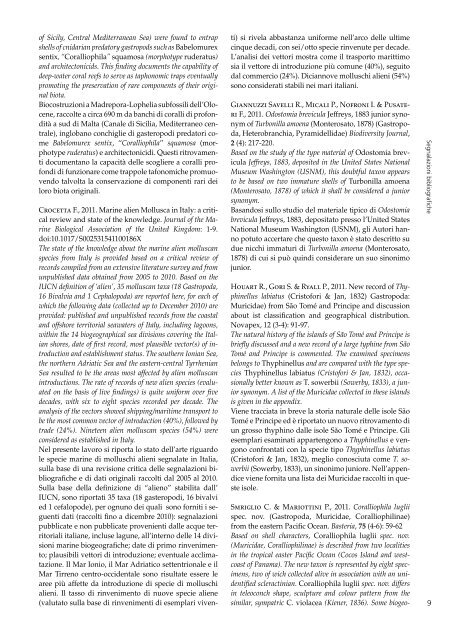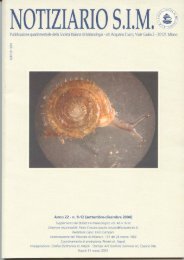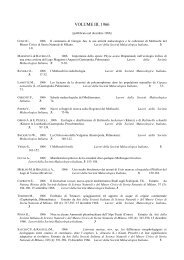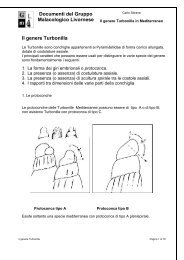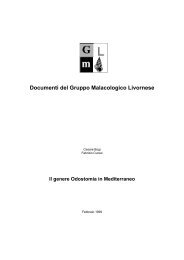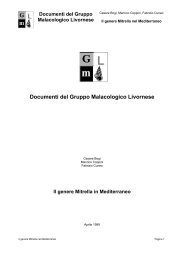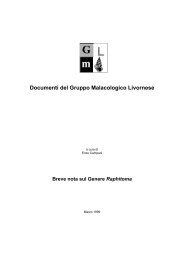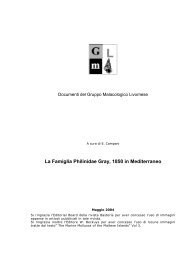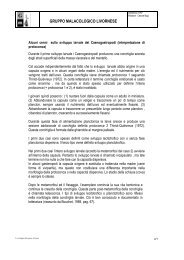of Sic<strong>il</strong>y, Central Me<strong>di</strong>terranean Sea) were found to entrapshells of cnidarian predatory gastropods such as Babelomurexsentix, ‘‘Corallioph<strong>il</strong>a’’ squamosa (morphotype ruderatus)and architectonicids. This fin<strong>di</strong>ng documents the capab<strong>il</strong>ity ofdeep-water coral reefs to serve as taphonomic traps eventuallypromoting the preservation of rare components of their originalbiota.Biocostruzioni a Madrepora-Lophelia subfoss<strong>il</strong>i dell’Olocene,raccolte a circa 690 m da banchi <strong>di</strong> coralli <strong>di</strong> profon<strong>di</strong>tàa sud <strong>di</strong> Malta (Canale <strong>di</strong> Sic<strong>il</strong>ia, Me<strong>di</strong>terraneo centrale),inglobano conchiglie <strong>di</strong> gasteropo<strong>di</strong> predatori comeBabelomurex sentix, ‘‘Corallioph<strong>il</strong>a’’ squamosa (morphotyperuderatus) e architectonici<strong>di</strong>. Questi ritrovamentidocumentano la capacità delle scogliere a coralli profon<strong>di</strong><strong>di</strong> funzionare come trappole tafonomiche promuovendotalvolta la conservazione <strong>di</strong> componenti rari de<strong>il</strong>oro biota originali.Crocetta F., 2011. Marine alien Mollusca in Italy: a criticalreview and state of the knowledge. Journal of the MarineBiological Association of the United Kingdom: 1-9.doi:10.1017/S002531541100186XThe state of the knowledge about the marine alien molluscanspecies from Italy is provided based on a critical review ofrecords comp<strong>il</strong>ed from an extensive literature survey and fromunpublished data obtained from 2005 to 2010. Based on theIUCN definition of ‘alien’, 35 molluscan taxa (18 Gastropoda,16 Bivalvia and 1 Cephalopoda) are reported here, for each ofwhich the following data (collected up to December 2010) areprovided: published and unpublished records from the coastaland offshore territorial seawaters of Italy, inclu<strong>di</strong>ng lagoons,within the 14 biogeographical sea <strong>di</strong>visions covering the Italianshores, date of first record, most plausible vector(s) of introductionand establishment status. The southern Ionian Sea,the northern Adriatic Sea and the eastern-central TyrrhenianSea resulted to be the areas most affected by alien molluscanintroductions. The rate of records of new alien species (evaluatedon the basis of live fin<strong>di</strong>ngs) is quite uniform over fivedecades, with six to eight species recorded per decade. Theanalysis of the vectors showed shipping/maritime transport tobe the most common vector of introduction (40%), followed bytrade (24%). Nineteen alien molluscan species (54%) wereconsidered as established in Italy.Nel presente lavoro si riporta lo stato dell’arte riguardole specie marine <strong>di</strong> molluschi alieni segnalate in Italia,sulla base <strong>di</strong> una revisione critica delle segnalazioni bibliografichee <strong>di</strong> dati originali raccolti dal 2005 al 2010.Sulla base della definizione <strong>di</strong> “alieno” stab<strong>il</strong>ita dall’IUCN, sono riportati 35 taxa (18 gasteropo<strong>di</strong>, 16 bivalvied 1 cefalopode), per ognuno dei quali sono forniti i seguentidati (raccolti fino a <strong>di</strong>cembre 2010): segnalazionipubblicate e non pubblicate provenienti dalle acque territorialiitaliane, incluse lagune, all’interno delle 14 <strong>di</strong>visionimarine biogeografiche; date <strong>di</strong> primo rinvenimento;plausib<strong>il</strong>i vettori <strong>di</strong> introduzione; eventuale acclimatazione.Il Mar Ionio, <strong>il</strong> Mar Adriatico settentrionale e <strong>il</strong>Mar Tirreno centro-occidentale sono risultate essere learee più affette da introduzione <strong>di</strong> specie <strong>di</strong> molluschialieni. Il tasso <strong>di</strong> rinvenimento <strong>di</strong> nuove specie aliene(valutato sulla base <strong>di</strong> rinvenimenti <strong>di</strong> esemplari viventi)si rivela abbastanza uniforme nell’arco delle ultimecinque deca<strong>di</strong>, con sei/otto specie rinvenute per decade.L’analisi dei vettori mostra come <strong>il</strong> trasporto marittimosia <strong>il</strong> vettore <strong>di</strong> introduzione più comune (40%), seguitodal commercio (24%). Diciannove molluschi alieni (54%)sono considerati stab<strong>il</strong>i nei mari italiani.Giannuzzi Savelli R., Micali P., Nofroni I. & PusateriF., 2011. Odostomia brevicula Jeffreys, 1883 junior synonymof Turbon<strong>il</strong>la amoena (Monterosato, 1878) (Gastropoda,Heterobranchia, Pyramidellidae) Bio<strong>di</strong>versity Journal,2 (4): 217-220.Based on the study of the type material of Odostomia breviculaJeffreys, 1883, deposited in the United States NationalMuseum Washington (USNM), this doubtful taxon appearsto be based on two immature shells of Turbon<strong>il</strong>la amoena(Monterosato, 1878) of which it shall be considered a juniorsynonym.Basandosi sullo stu<strong>di</strong>o del materiale tipico <strong>di</strong> Odostomiabrevicula Jeffreys, 1883, depositato presso l’United StatesNational Museum Washington (USNM), gli Autori hannopotuto accertare che questo taxon è stato descritto sudue nicchi immaturi <strong>di</strong> Turbon<strong>il</strong>la amoena (Monterosato,1878) <strong>di</strong> cui si può quin<strong>di</strong> considerare un suo sinonimojunior.Houart R., Gori S. & Ryall P., 2011. New record of Thyphinelluslabiatus (Cristofori & Jan, 1832) Gastropoda:Muricidae) from São Tomé and Principe and <strong>di</strong>scussionabout ist classification and geographical <strong>di</strong>stribution.Novapex, 12 (3-4): 91-97.The natural history of the islands of São Tomé and Principe isbriefly <strong>di</strong>scussed and a new record of a large typhine from SãoTomé and Principe is commented. The examined specimensbelongs to Thyphinellus and are compared with the type speciesThyphinellus labiatus (Cristofori & Jan, 1832), occasionallybetter known as T. sowerbii (Sowerby, 1833), a juniorsynonym. A list of the Muricidae collected in these islandsis given in the appen<strong>di</strong>x.Viene tracciata in breve la storia naturale delle isole SãoTomé e Principe ed è riportato un nuovo ritrovamento <strong>di</strong>un grosso thyphino dalle isole São Tomé e Principe. Gliesemplari esaminati appartengono a Thyphinellus e vengonoconfrontati con la specie tipo Thyphinellus labiatus(Cristofori & Jan, 1832), meglio conosciuta come T. sowerbii(Sowerby, 1833), un sinonimo juniore. Nell’appen<strong>di</strong>ceviene fornita una lista dei Muricidae raccolti in questeisole.Smriglio C. & Mariottini P., 2011. Corallioph<strong>il</strong>a lugliispec. nov. (Gastropoda, Muricidae, Corallioph<strong>il</strong>inae)from the eastern Pacific Ocean. Basteria, 75 (4-6): 59-62Based on shell characters, Corallioph<strong>il</strong>a luglii spec. nov.(Muricidae, Corallioph<strong>il</strong>inae) is described from two localitiesin the tropical easter Pacific Ocean (Cocos Island and westcoastof Panama). The new taxon is represented by eight specimens,two of wich collected alive in association with an unidentifiedscleractinian. Corallioph<strong>il</strong>a luglii spec. nov. <strong>di</strong>ffersin teleoconch shape, sculpture and colour pattern from thesim<strong>il</strong>ar, sympatric C. violacea (Kiener, 1836). Some biogeo-Segnalazioni bibliografiche9
Segnalazioni bibliografiche10graphical implications of the co-occurrence of C. violacea andC. luglii in the tropical eastern Pacific are <strong>di</strong>scussed.Viene descritta Corallioph<strong>il</strong>a luglii spec. nov. (Muricidae,Corallioph<strong>il</strong>inae) in base ai caratteri conchigliari provenienteda due località tropicali dell’Oceano Pacificoorientale (Isole Cocos e costa occidentale <strong>di</strong> Panama). Intutto sono stati raccolti 8 esemplari della nuova specie,due dei quali viventi su uno sclerattinario non determinato.Corallioph<strong>il</strong>a luglii spec. nov. <strong>di</strong>fferisce da C. violacea(Kiener, 1836), specie simpatrica e sim<strong>il</strong>e, per la formadella teleoconca, la scultura ed <strong>il</strong> colore. Sono commentatealcune implicazioni della coesistenza della C. violaceae C. luglii nell’Oceano Pacifico tropicale orientale.Pusateri F., Giannuzzi-Savelli R. & Oliverio M., 2012.A revision of the Me<strong>di</strong>terranean Raphitomidae 1: on thesibling species Raphitoma contigua Monterosato, 1884and Raphitoma spa<strong>di</strong>ana n. Sp. (Gastropoda, Conoidea).Iberus, 30 (1): 41-52.A new raphitomid toxoglossan, Raphitoma spa<strong>di</strong>ana n. sp.,is described from the Me<strong>di</strong>terranean Sea. It is the sister speciesto R. contigua Monterosato, 1884, from wich it <strong>di</strong>ffers in the<strong>di</strong>fferent protoconch (paucispiral vs. multispiral), ad<strong>di</strong>ng to along list of pairs of caenogastropod species <strong>di</strong>ffering in theirlarval development.Viene descritta dal Me<strong>di</strong>terraneo un nuovo rafitoma toxoglosso:Raphitoma spa<strong>di</strong>ana n. sp. È una specie sorella<strong>di</strong> R. contigua Monterosato, 1884 dalla quale <strong>di</strong>fferisceper la <strong>di</strong>fferente protoconca (paucispirale per <strong>il</strong> primo emultispirale per <strong>il</strong> secondo è aggiunta una lunga lista <strong>di</strong>coppie <strong>di</strong> caenogastropoda che <strong>di</strong>fferiscono nel loro sv<strong>il</strong>uppolarvale.Rolán E. & Gori S., 2012. New species of neogastropodsfrom the islands of the Gulf of Guinea, West Africa. Iberus,30 (1): 53-66.Material collected from a recent expe<strong>di</strong>tion by the second author(SG) to Principe Island in the Guinean Gulf is stu<strong>di</strong>ed.Material from nearby islands that was waiting for publicationis also included. The new species proposed here belong to thegenera Anachis (1 species) and Mitrella (1 species) in thefam<strong>il</strong>y Columbellidae, and Mitromorpha (3 species) in thefam<strong>il</strong>y Mitromorphidae, superfam<strong>il</strong>y Conoidea.Viene stu<strong>di</strong>ato <strong>il</strong> materiale raccolto dal secondo autore(S.G.) durante una recente spe<strong>di</strong>zione all’isola Principedel Golfo <strong>di</strong> Guinea. È anche incluso <strong>il</strong> materiale provenientedalle vicine isole in attesa <strong>di</strong> pubblicazione. Lenuove specie qui proposte appartengono ai generi Anachis(1 specie) e Mitrella (1 specie) della famiglia Columbellidae,e Mitromorpha (3 specie) della famiglia Mitromorphidae,superfamiglia Conoidea.Campani E., Bartolini S. & Spanu M.T., 2012. Alvaniagarrafensis Peñas & Rolán 2008 (Gastropoda: Rissoidae)from Croatian waters. Iberus, 30 (1): 85-89.We report on the presence of numerous specimens of Alvaniagarrafensis Peñas & Rolán 2008 from shell grit <strong>di</strong>ved in shallowwaters near several islands of the Quarnero Gulf, NorthAdriatic Sea, Croatia. The species was up to known only fromGarraf littoral, Barcelona, East Spain and the present recordsgreatly extend its geographical <strong>di</strong>stribution. Hypotheses thatcould explain such a large range extension are considered.Riferiamo sulla presenza <strong>di</strong> numerosi esemplari <strong>di</strong> Alvaniagarrafensis Peñas & Rolán, 2008 provenienti da detritoprelevato a seguito <strong>di</strong> immersioni in acque basse <strong>di</strong> numeroseisole del Golfo del Quarnero, Mare Adriatico settentrionale,Croazia. La specie è conosciuta solo per <strong>il</strong> litoraledel Garraf, Barcellona, Spagna orientale e l’attualeritrovamento estende notevolmente <strong>il</strong> suo areale <strong>di</strong> <strong>di</strong>stribuzione.Vengono prese in considerazione ipotesi chepotrebbero spiegare tale grande <strong>di</strong>ffusione.La Marca E.C., M<strong>il</strong>azzo M. & Chemello R., 2011. Glieffetti del <strong>di</strong>sturbo antropico sulla topografia del reef avermeti. Biologia Marina Me<strong>di</strong>terranea, Atti del XLII Congressodella Soc. Di Biologia Marina, Olbia (OT) 23-28maggio 2011: 54-55.[The effects of human <strong>di</strong>sturbance on the topography ofa vermetid reef]. Intertidal vermetid reefs could be affectedby many human <strong>di</strong>sturbances. Using a microtopography device,the authors analysed the changes induced by the accessib<strong>il</strong>ityon the surface topography of the reefs. Human activitiesseems to be able to induce a decrease in rugosity and a surfacesmoothing on the outer margin of the reef. These effects areproportional to the accessib<strong>il</strong>ity of the site.I reefs a vermeti possono essere influenzati da <strong>di</strong>verse attivitàumane. Ut<strong>il</strong>izzando uno strumento topografico, gliautori hanno analizzato i cambiamenti indotti dalla accessib<strong>il</strong>itàsulla topografia superficiale dei reefs. L’azioneantropica sembra essere in grado <strong>di</strong> determinare una <strong>di</strong>minuzionedella rugosità e l’abrasione della superficiedel margine esterno del reef in maniera proporzionaleall’accessib<strong>il</strong>ità del sito.S. Coppa, G.A. De Lucia, A. Camedda, G. Massaro, A.Petrocelli, E.Cecere & P. Magni, 2011. Patella ferrugineanell’AMP del Sinis: caratterizzazione dell’habitat ecause della sua rarefazione. Atti del XLII Congresso dellaSoc. Di Biologia Marina, Olbia (OT) 23-28 maggio 2011:244-245.In questo stu<strong>di</strong>o, condotto nell’Area Marina Protetta dellaPenisola del Sinis-Isola <strong>di</strong> Mal <strong>di</strong> Ventre (Sardegna occidentale),è stata esaminata una popolazione <strong>di</strong> Patellaferruginea e la fauna associata mesolitorale. Sono stateidentificate 60 specie e P. ferruginea ha la più bassa densitàmai riportata (0.02 ind/m). I risultati evidenziano unapopolazione <strong>di</strong> P. ferruginea in grave pericolo <strong>di</strong> estinzionee la pressione antropica è l’effetto negativo maggioresu questo fenomeno. Suggeriamo l’adozione <strong>di</strong> misure <strong>di</strong>protezione, compreso l’aumento della sorveglianza locale,per evitare la scomparsa della popolazione locale.[Patella ferruginea in the Sinis MPA: habitat characterizationand causes of its decline] In this study, carried out inthe Penisola del Sinis-Isola <strong>di</strong> Mal <strong>di</strong> Ventre (W-Sar<strong>di</strong>nia)Marine Protected Area, a population of the giant Patella ferrugineaand the associated midlittoral assemblage were esamine.A total of 60 species were identified and P. ferrugineashowed the lowest mean density ever reported (0.02 ind/m).The results demonstrated a highly endagered population of P.ferruginea and human pressure had a major negative effect
- Page 4 and 5: Verbale:Riunione del Consiglio Dire
- Page 6 and 7: Riteniamo doveroso ringraziare Igna
- Page 8 and 9: Segnalazioni bibliograficheContinui
- Page 12 and 13: on its occurrence. We suggest the a
- Page 14 and 15: in un’area compresa tra l’alta
- Page 16 and 17: partiti dall’elenco sistematico d
- Page 18 and 19: Chirli C. & Linse U., 2011. The Ple
- Page 20 and 21: (Gastropoda, Muricidae, Coralliophi
- Page 22 and 23: Delongueville C., Scaillet R. & Afo
- Page 24 and 25: dre: Veneroida (suite 8), Super-fam
- Page 26 and 27: Notiziario S.I.M. 30 (1) p. 01-02 g
- Page 28 and 29: Notiziario S.I.M. 30 (1) p. 03-11 g
- Page 30 and 31: Il Genere Lindapterys Petuch, 1987
- Page 32 and 33: Il Genere Lindapterys Petuch, 1987
- Page 34 and 35: arrotondate; sugli ultimi giri si s
- Page 36 and 37: turelle, 4ème série - section A.
- Page 38 and 39: osi esemplari, anche se non penso c
- Page 40 and 41: RingraziamentiRingrazio Enzo Campan
- Page 42 and 43: Chilostoma achates achates (Rossmä
- Page 44 and 45: - Varietà rhaeticum (Strobel, 1857
- Page 46 and 47: Considerazioni tassonomiche su alcu
- Page 48 and 49: Fig. 9. Forme intermedie fra C. zon
- Page 50 and 51: Figura 11. A. Chilostoma zonatum fl
- Page 52 and 53: Bi o n d e l l o: As much as an app
- Page 54 and 55: cuzione da considerare è cockle ha
- Page 56 and 57: Notiziario S.I.M. 30 (1) p. 31-34 g
- Page 58 and 59: BIVALVIA Frequenza AmbienteArca noa
- Page 60 and 61:
Notiziario S.I.M. 30 (1) p. 35-36 g
- Page 62:
SommarioCuriosità1 Renda W. La Rub


